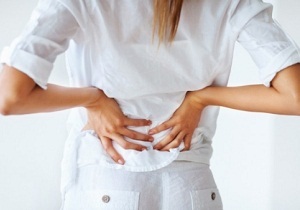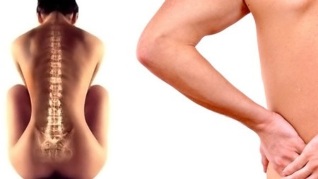If we are to believe the statistics, 70% and 80% of the population of our country at least once in life faces with the back pain in the lumbar area, or, in medical terms, pain in the lower back. Its prevalence in the uk is 59 per cent, in denmark 70%, in finland is 75%. Among all those issued by "the hospital" in our country one third of the falls in the cases of back pain.

The causes of pain in the low back can be very diverse — from psychogenic factors before the metastasis of the cancer. Fortunately, serious diseases represent no more than 5% of the cases of pain in the lower part of the back, its main reason is the over-strain or spasm of the muscles, as well as other problems of the locomotor apparatus.
Types of back pain in the lumbar area
The pain in the back, as in any other organ, is diverse. Often it is precisely the character of the pain is the first symptom that the doctor can make a guess about the nature of the disease.
In its origin the back pain can be:
- primary — caused by chronic diseases, functional or dystrophic changes in the tissues of the spine and muscles, sometimes with the involvement of neighbouring structures — roots of the spinal nerves.
- secondary is caused by injury, inflammation, arthritis, or degenerative disease, the intervertebral joints, the defeat of the internal organs.
The duration of the pain can be:
- acute — damage occurs, or recently emerged from the condition closely with him relates, lasts up to 6 weeks;
- podostraya — lasts 6 to 12 weeks;
- chronic — of a duration of more than 12 weeks.
Typical of the clinical manifestations will depend on the source of pain.
Muscle-tonic and other pain syndromes
The supercooling, the constant of the uncomfortable posture during the working time or leisure, incorrect stereotypes engines, degenerative diseases of the spine, which change the height and elasticity of intervertebral discs, lead to the fact that the load on the muscles which is distributed unevenly. Some of them are constantly overwhelmed by what, by contrast, do not receive the necessary load. Accordingly, in certain muscles begin spasm, causing pain. Appear the so-called trigger point, impact, which reinforces the spasm and the pain. Specific characteristics of the pain:
- clearly limited local area of the pain);
- it feels deep in the muscle layer;
- in the muscle detectable tight tight plot, or range, within which are detected especially the painful points;
- when exposed to these points drastically the pain intensifies, making the patient shake (symptom of jump);
- limitation of the mobility;
- if you can stretch a muscle — the pain decreases.
It is in this type of pain work well ointment that hot or popular accessories. The truth, the effect of them of short duration, since the cause of the spasm of the muscles, is not fixed. The most reliable method of injection of the analgesic medication directly into trigger point, as well as kinesiotherapy, physiotherapy, chiropractic.
Compression radiculopathy
It is caused by compression or stretching of the roots of the spinal nerves by the herniated disc or the reduction of its height and, as a consequence, the distance between the vertebrae. This pain often feels like "superficial", it is spreading more in the skin than in the depth of the tissues. She sharply is strengthened through the sneezing, the coughing, the load on the spine. Such is the pain it feels like the classic "throw", the assignor of the march of the nerve root.
Spinal stenosis
Occurs due to a herniated disc, thrust (protrusions) of the party in the vertebral canal or of the occurrence of kidnapping — exfoliated part of a disk. One way or another, be compressed during the education under the name of "horse's tail" — heels of the feet of the spinal nerves, Innervating the lower limbs. The pain when this spreads throughout of the progress of the nerve root, from the waist to the pit stop, appears at rest and at rest and when walking, it strengthens the correct extension of the spine, and is reduced when leaning forward.
Special syndrome
It is called the pathology of the small intervertebral (facet) joints. The pain may be local, so as to radiate (give) in the groin, the tail bone of the back of the thigh. Reinforcing slopes and rotation in the lower part of the back.
All of these types of pain syndrome appear severe, on occasions, the patient may even say, on what day and after an impact, since it is raised, not returned, etc). The pain intensifies at evening and after physical activity, reduce after the break. Often this type of pain is typical of people of middle age or older.

Inflammatory pain
Is caused by inflammatory of the defeat of the joints of the spinal column is of different type, arthritis: rheumatoid arthritis, disease of Reuter's, ankylosing spondylitis, etc Inflammatory pain often occurs in the relationship of young people, develops gradually. It is maximum at the beginning of the day and is reduced late in the afternoon or after physical activity. Often accompanied by morning stiffness.
Other possible causes of back pain — pathology of the internal organs, for example kidney disease or the inflammation of the appendices of the women. Because many diseases can be manifested in a similar way, at least in regard to the syndrome of pain, it is better not to fall in the diagnosis same and consult a doctor.
Immediate consultation of a specialist is required in the event that:
- the pain appeared after the injury, especially in aged women;
- in history there are oncology services of the disease;
- the pain is accompanied with an increase of the temperature;
- abruptly and without apparent reason, it reduces the weight;
- changes the mode of walking or are removed from the feet;
- appear difficulties in urination and defecation.
These signs could be the manifestation of the worst diseases that require immediate treatment.
The diagnosis of the pathology
Aches and pains in the back and the lumbar area to your doctor before everything you should to exclude a danger to the life of the state — to happiness, are quite rare.
General and biochemical analysis of blood allow to identify inflammatory changes, to detect elevated levels of calcium, characteristic of metastases of malignant tumors in bone structure, changes in the number of blood cells to the myeloma of the disease, and so on. Older men can be assigned to an analysis of prostate-specific antigen in order to exclude the possibility of prostate cancer.
X-ray survey detects a change in height of the intervertebral discs, possible osteophytes — bone expansion, caused by the poorly distributed load on the vertebrae, the change of the shape of the vertebrae.
The ct scan and the mri will show bulging of the intervertebral disc, calcification (calcification), spinal stenosis.
Today in time of these two studies comes gradually ultrasound of the vertebral column that allows to detect the same changes, not to submit the patient from excessive radiation load.
Is obligatory the consultation of the neurologist, by the indications — chiropractic.
After the full survey makes clear the strategy of treatment. As a general rule, deal with the pain in the lumbar area can therapeutic methods of operation are shown relatively rarely.
The pharmacological treatment of pain in the lumbar region of the back
In 95% of cases the patient not to worry — usually, the back pain is not a threat to health and can be curable. Myofascial pain syndrome is adjusted more quickly to resolve radicular pain may take several months. One way or another, in most cases, it is necessary to medication therapy. Use nonsteroidal anti-inflammatory agents (nsaids) to relieve pain and reduce inflammation, medicines to keep the cartilage intervertebral. Sometimes to reduce the pain and edema prescription and hormonal drugs — act faster non-steroidal anti-inflammatory that is injected in the form of blocks and emitters under the supervision of a doctor.
The drugs may be in the form of ointments and gels — this method of treatment of pain in the lower part of the back popular the advertisements. But as the method of introduction into the organism of the active substance the use of external means — more ineffective that you can predict, because most of the tools or even penetrates through the skin.
Another popular technique — intake of medication, or, simply, tablets and capsules. Taking the pill is not difficult, the effect occurs quite quickly — usually within half an hour-an hour, but the long-term use of medications can affect the state of the gastrointestinal tract.
Therefore, the fastest and most effective way to relieve the pain of the injection directly into the muscle or the affected area of your spine, the so-called blockade. Its only disadvantage is the strict requirement of high-qualified doctor that will perform the handling of cargo.
Non-drug therapy
As a general rule, that the medication is supplemented with non-drug methods. What physical therapy needs, you choose the primary care doctor. This can be a classic massage or chiropractic, and osteopathic procedures, as well as the iglorefleksoterapija. Is gaining popularity and kinesitherapy special gymnastics in the form of special classes the decompression simulators, which help to relieve tense muscles, to generate new motor stereotypes, thus eliminating the cause of back pain.

Therefore, the best treatment option for back pain — the combination of pharmacological methods and non medication approach. This complex work in several directions fast to face the disease, to completely get rid of pain or get a long-term effect.

























